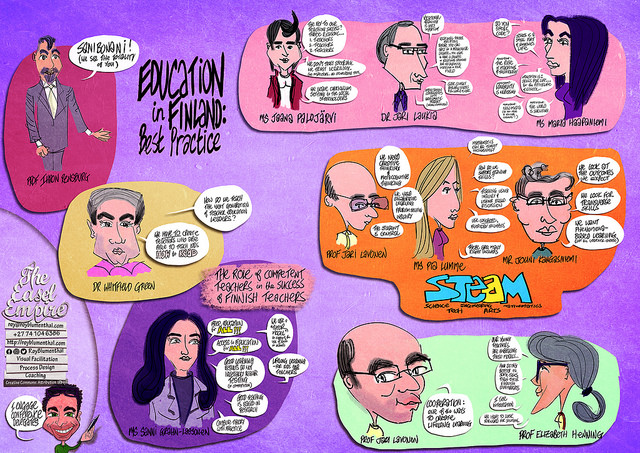Updated
Finding the Right Education Model for Morocco – Ambassador Edward M. Gabriel (ret.)

Education in Finland — Best Practices Photo: Roy Blumenthal
Ambassador Edward M. Gabriel (ret.)
September 26, 2018
 Much has been written about the Finnish education miracle, so much so that I decided to examine if it makes sense for a country like Morocco. In doing so, I found that the Finnish model is an amalgamation of the best practices from other countries. There are other models in East Asia, as well, which together provide a fuller appreciation of the best models in the world.
Much has been written about the Finnish education miracle, so much so that I decided to examine if it makes sense for a country like Morocco. In doing so, I found that the Finnish model is an amalgamation of the best practices from other countries. There are other models in East Asia, as well, which together provide a fuller appreciation of the best models in the world.
The World Bank’s Education for Global Development blog provides us with a close view of the Finnish model, as well as others from around the world that have succeeded in efforts to become among the best schooling systems in the world.
In Finland teachers are valued. Only about 10% of those who apply get accepted into the elementary school system. All schools in the country are of equal quality and there is no geographical discrimination, something that would be valuable in a country as culturally diverse as Morocco.
In Finland, teachers are supported by other experts such as psychologists, special education specialists, and school leadership. The school system also promotes continuing education for teacher professional development, experiments with new technologies and methods, and provides a variety sports and other extracurricular activities.
In Finland, securing the student’s well-being is a major objective as special attention is paid to the student’s nutrition, health, safety, and overall happiness.
Pasi Sahlberg argues in Education Week argues that part of Finland’s success has stemmed from “being open to learning from other education systems,” particularly the Swedish, German, and Anglo-Saxon models and their evolution over the last 100 years. He explains how innovative ideas from the United States have also had an impact since the 1980s, particularly the “cooperative learning” process. This type of learning is a “successful teaching strategy in which small teams, each with students of different levels of ability, use a variety of learning activities to improve their understanding of a subject. Each member of a team is responsible not only for learning what is taught but also for helping teammates learn, thus creating an atmosphere of achievement. Documented results include improved academic achievement, improved behavior and attendance, increased self-confidence and motivation, and increased liking of school and classmates. Cooperative learning is also relatively easy to implement and is inexpensive”. No where do we find that the French system of education is held up as a model, the prevalent system in Morocco.
The case for East Asia also provides powerful facts in support of the best educational models for the world. Raja Bentaouet Kattan, Country Manager for Yemen at the World Bank, points out that “East Asia is home to seven of the top ten education systems in the world.” She writes, “Among countries with the strongest education systems, attention is shifting from a uniform, teacher-centered, exam-oriented pedagogy towards diverse, student-centered learning pathways that aim to instill capabilities for lifelong learning. This shift represents an increased focus on 21st century skills under three categories: 1) Learning and Innovation, 2) Digital Literacies, and 3) Life and Career Skills. In short, East Asia aspires for its students to know themselves, relate well with others and be worldly as well as think creatively and independently with a sea of ubiquitous knowledge at their fingertips.”
In Singapore, Japan, the Republic of Korea, and Hong Kong (China), there is a recognition of a fast changing global economy and focusing on “learning to learn,” enabling students to develop flexibility and adaptability in order to keep up in “dynamic labor market demands,” adopting more flexible curriculum and getting away from a “set” curriculum.
Kattan describes a “shift away from knowledge acquisition (historically based on rote memorization) toward development of competencies (or skills). In Japan, for example, the change is manifested and framed away from “what do students know” towards “what can they do with what they know.” She goes on to discuss the importance that “classrooms include project-based activities, problem- and theme-based integrated learning, experiential learning, and activities that involve group-based research, debate, discussions and presentations.”
And, like in Finland, the Asia models select and support teachers throughout their lives. These are lessons not only for Morocco but the US as well, given its lack of support for its elementary and secondary teachers, who are among the lowest paid professionals in the US.
Morocco has its own educational innovations. One of the most interesting is being implemented by the OCP company in Khouribga where the first school, specializing in programming and coding, opened its doors this month. The program aims to form a class of 150 students focused on the future of computer science in a unique setting. There are no teachers, no lessons, no books, no fixed hours, but 24-hour open facilities. Peers can build an active and cooperative learning environment. Students between the ages of 18 and 30, with or without a baccalaureate, will go through a rigorous process or “swimming pool,” after which they will be able to benefit from three years of training.
To advance its educational vision, Morocco should study the best examples around the world that fit its own culture and vision and come up with a working model for the future of its children. This will enable them to compete in the world in the long term, and also tackle high illiteracy rates, unemployment, and disenchanted and disfranchised youth.
Morocco is in a race with other countries globally to make better use of their human resources, especially youth and women. Understanding trends in labor and developing an educational strategy that is flexible and efficient in meeting market needs will give youth the tools they need to succeed. A highly educated population equipped with the right learning tools, added to important reforms and infrastructure development will most certainly put Morocco on the right path for the future.